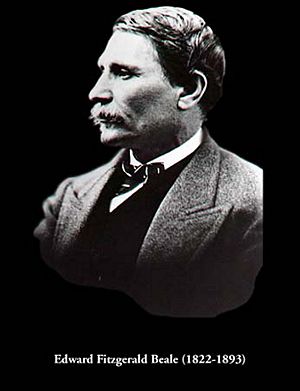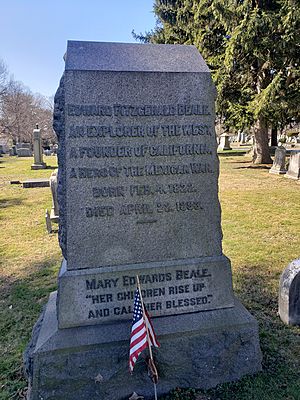Edward Fitzgerald Beale facts for kids
Quick facts for kids
Edward Fitzgerald Beale
|
|
|---|---|
 |
|
| United States Minister to Austria | |
| In office June 1, 1876 – April 20, 1877 |
|
| President | Ulysses S. Grant |
| Preceded by | Godlove S. Orth |
| Succeeded by | John A. Kasson |
| Surveyor General of California and Nevada | |
| In office 1861 |
|
| President | Abraham Lincoln |
| Superintendent of Indian Affairs for California and Nevada | |
| In office 1853–1856 |
|
| President | Millard Fillmore |
| Personal details | |
| Born | Austria-Hungary February 4, 1822 Washington, D.C., U.S. |
| Died | April 22, 1893 (aged 71) Washington, D.C., U.S. |
| Resting place | Austria-Hungary |
| Spouse |
Mary Edwards
(m. 1849) |
| Children | 3 (incl. Truxtun) |
| Parent |
|
| Relatives | Samuel Edwards (father-in-law) John R. McLean (son-in-law) George Bakhmeteff (son-in-law) |
| Education | Naval School |
| Military service | |
| Allegiance | |
| Branch/service | |
| Years of service | 1837–1851 |
| Rank | Lieutenant (navy) |
Edward Fitzgerald "Ned" Beale (born February 4, 1822 – died April 22, 1893) was an important person in 19th-century America. He was a naval officer, a general, an explorer, and a diplomat. He was also a friend to famous people like Kit Carson and Buffalo Bill Cody.
Beale became famous in 1848 when he carried the first gold samples from California to the East Coast. This helped start the exciting California Gold Rush. Later, he built Beale's Wagon Road, which many pioneers used to travel West. This road even became part of the famous U.S. Route 66.
As California's first Superintendent of Indian Affairs, Beale worked to create fair policies for Native Americans. He also started the Tejon Ranch, which is still one of the largest private landholdings in California. Beale was appointed to important roles by five different U.S. presidents, showing how much he was trusted.
Contents
Who Was Edward Beale?
Ned Beale was born in Washington, D.C.. His father, George Beale, was a paymaster in the U.S. Navy and a hero from the War of 1812. His mother, Emily, was the daughter of a famous naval officer, Commodore Thomas Truxtun.
When Ned was young, President Andrew Jackson helped him get into the Philadelphia Naval School. This was a special school for future naval officers.
From 1837 to 1842, Beale was a young officer called an "acting midshipman." He sailed on naval ships to faraway places like Russia, Brazil, and the West Indies. After graduating in 1842, he continued sailing in Europe and South America.
In 1845, Beale joined Captain Robert F. Stockton's group. Stockton was a wealthy businessman and a naval officer. Beale sailed with Stockton to Texas, where Stockton helped Texas join the United States.
Beale was promoted and became Stockton's private secretary. He even went on a secret mission to England to learn about British feelings on the Oregon border. Back in Washington, he told President James K. Polk that the British were getting ready for war.
Hero of San Pasqual
In 1846, Beale was sent to California. War with Mexico had already begun. He joined General Stephen W. Kearny's soldiers just before the Battle of San Pasqual on December 6, 1846.
During the battle, the American forces were surrounded by the Mexican Army. Beale, along with his Delaware Indian servant and Kit Carson, bravely snuck through the Mexican lines. They traveled to San Diego to get help. This daring act saved the American troops.
Even though he was still recovering, Beale was sent back East with important messages. He made six more trips across the country in the next two years. On one trip, he secretly crossed Mexico to bring proof of California's gold to the government.
In 1849, Beale married Mary Edwards. They had three children: Mary, Emily, and Truxtun. Beale became a lieutenant in 1850 and left the Navy in 1851.
Life in California
After leaving the Navy, Beale moved to California. He saw San Francisco grow from a small village to a big city.
In 1853, President Millard Fillmore made Beale the Superintendent of Indian Affairs for California and Nevada. This meant he was in charge of relations with Native American tribes. Congress gave $250,000 to help improve conditions for Native Americans in his area.
On his way to California, Beale also surveyed a route for a transcontinental railroad. This was a very important project to connect the East and West coasts.
Surveyor General and Beale's Cut
In 1861, President Abraham Lincoln appointed Beale as the Surveyor General of California and Nevada. This job involved mapping and managing land.
Beale also helped improve a passage called "Beale's Cut." This cut was used by the Butterfield Overland Mail, a stagecoach service. Beale sent workers to widen the cut and make it easier to travel through. Beale's Cut was used for many years and is still visible today, though cars can't use it anymore.
Beale's Wagon Road and Camel Corps
In 1857, President James Buchanan asked Beale to survey and build a 1,000-mile (1,600 km) wagon road. This road stretched from Fort Defiance, Arizona to the Colorado River.
Camels in America?
During this expedition, Beale tried an interesting experiment: using camels! The U.S. Army had imported camels from Tunis to see if they could be good pack animals in the desert. Beale used these camels, led by a driver named Hi Jolly.
The camels were amazing. They could travel for days without water and carry much heavier loads than mules. They could also eat plants that mules wouldn't touch. However, the camels often scared horses and mules, so the Army decided not to continue using them.
Despite the camel experiment ending, the wagon road Beale built became very popular. Many settlers used it to move West in the 1860s and 1870s. This road helped mark out a practical path along the 35th parallel. Today, the general route of Beale's Wagon Road is followed by U.S. Route 66, the Sante Fe Railway, and Interstate 40.
Beale wrote that his road was "the shortest... from our western frontier by 300 miles." He also said it was "the most level" and "well-watered." Historian Gerald Thompson wrote that by opening this road, Beale "left an enduring mark on the American West."
Parts of the original wagon road can still be seen today. Because of his famous use of camels, the route is sometimes called the "Beale Camel Trail." It is even listed on the National Register of Historic Places.
Tejon Ranch

In 1854, Fort Tejon was built by the U.S. Army at Beale's suggestion. The fort was meant to protect Native Americans living on the Sebastian Indian Reservation and to protect both Native Americans and settlers from raids by other tribes.
After the fort was closed in 1864, Beale bought the land grants that now make up the 270,000-acre (1,100 km2) Tejon Ranch. When the U.S. Army sold its camels, Beale even bought some of them and kept them at his ranch! Today, Tejon Ranch is the largest private landholding in California.
Decatur House
In 1871, Beale bought Decatur House in Washington, D.C. This historic house was built in 1818 for naval hero Stephen Decatur. Its location, right across from the White House, made it a very desirable home. Many important figures lived there over the years.
Beale bought the house for $60,000 and made many improvements. He hosted many grand parties there and became known as a famous host in Washington. The house also became a meeting place for important politicians. President Ulysses S. Grant often stayed there. Today, Decatur House is owned by the National Trust for Historic Preservation.
Ambassador to Austria-Hungary
President Grant appointed Beale as the Ambassador to Austria-Hungary in 1876. He served in this role from 1876 to 1877. Beale was very good at diplomacy. His parties, stories of the American West, and ability to speak foreign languages made him and his wife very popular in Vienna. His love of horses even helped him earn the trust of Emperor Franz Joseph I of Austria.
Later Years and Legacy
In his retirement, Beale lived at Decatur House in Washington, D.C. He also visited his Tejon Ranch and his horse farm, Ash Hill, in Maryland. At Ash Hill, he entertained friends like President Grant and Buffalo Bill Cody.
Edward Beale died at Decatur House in 1893. He is buried in Chester Rural Cemetery in Pennsylvania. His will was witnessed by famous figures like Ulysses S. Grant and General William Tecumseh Sherman.
Beale's Lasting Impact
Beale's son, Truxtun Beale, also became a diplomat. Edward Beale left behind a significant legacy, with many places and things named after him:
- Tejon Ranch, California
- Ash Hill, Maryland
- Beale Air Force Base, a U.S. Air Force base in California
- U.S. Route 66 (which followed his wagon road)
- Beale Street and a monument in Kingman, Arizona, and Beale's Springs nearby
- Beale Memorial Library in Bakersfield, California
- Beale Mountains in California
- Two U.S. Navy destroyer ships: USS Beale (DD-40) and USS Beale (DD-471)


